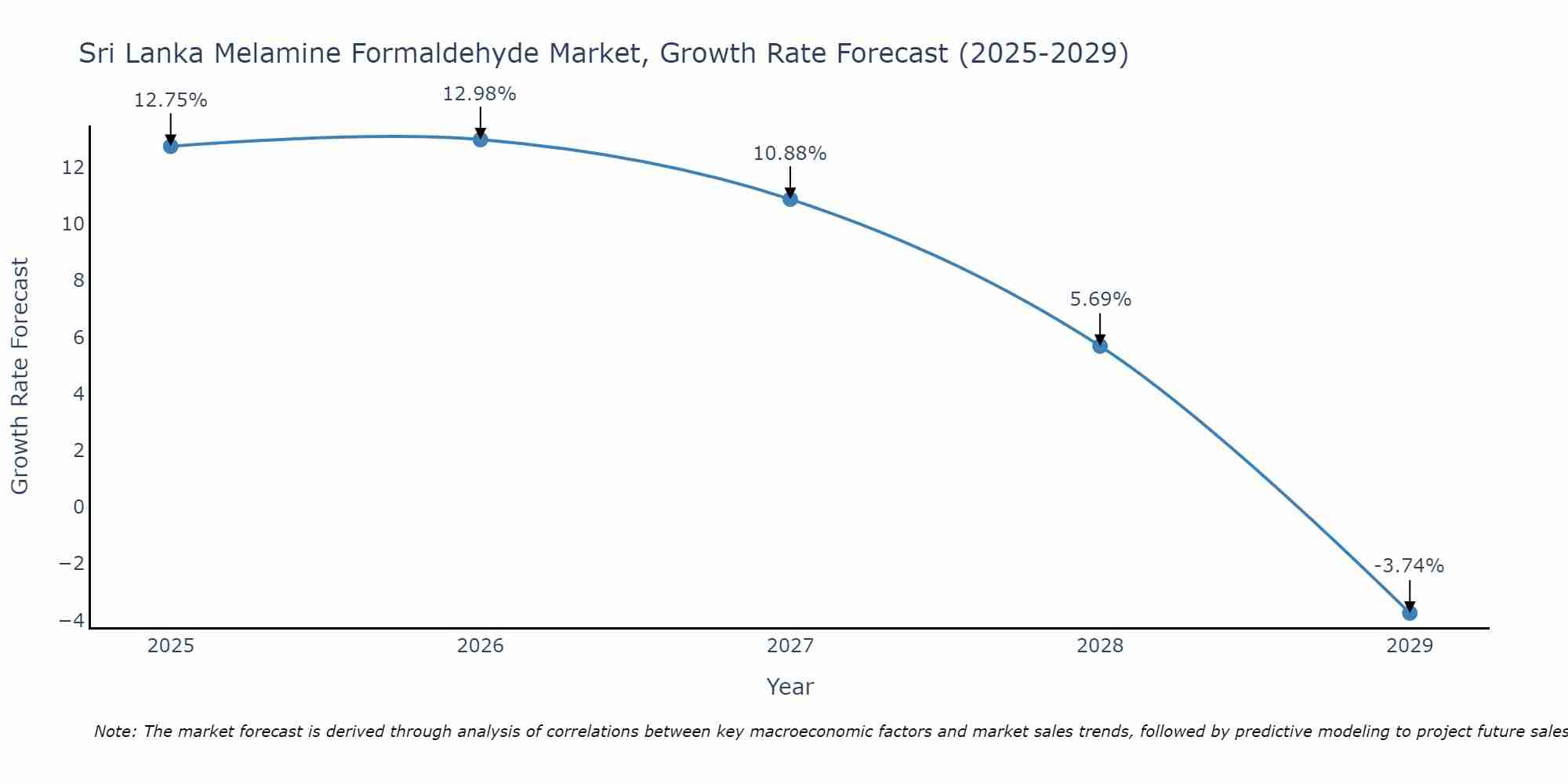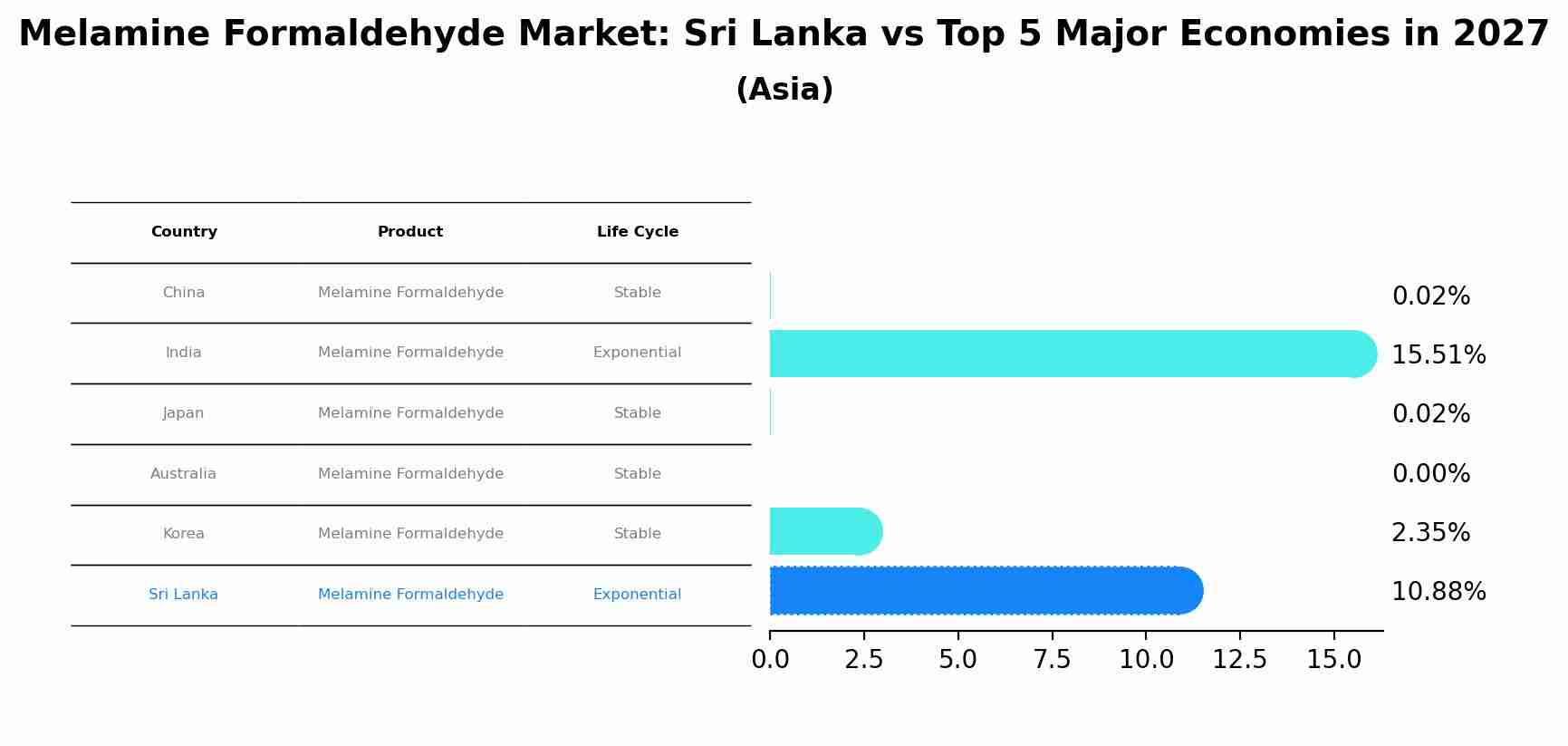Sri Lanka Melamine Formaldehyde Market (2025-2031) Outlook | Trends, Industry, Value, Revenue, Companies, Share, Analysis, Growth, Forecast & Size
| Product Code: ETC110150 | Publication Date: Jun 2021 | Updated Date: Apr 2025 | Product Type: Report | |
| Publisher: 6Wresearch | No. of Pages: 70 | No. of Figures: 35 | No. of Tables: 5 | |
Sri Lanka Melamine Formaldehyde Market Size Growth Rate
The Sri Lanka Melamine Formaldehyde Market is projected to witness mixed growth rate patterns during 2025 to 2029. Growth accelerates to 12.98% in 2026, following an initial rate of 12.75%, before easing to -3.74% at the end of the period.

Melamine Formaldehyde Market: Sri Lanka vs Top 5 Major Economies in 2027 (Asia)
In the Asia region, the Melamine Formaldehyde market in Sri Lanka is projected to expand at a high growth rate of 10.88% by 2027. The largest economy is China, followed by India, Japan, Australia and South Korea.

Sri Lanka Melamine Formaldehyde Market Overview
Sri Lanka melamine formaldehyde market is growing with applications in construction materials, furniture manufacturing, and automotive components. Melamine formaldehyde resins offer properties such as heat resistance, durability, and dimensional stability, making them suitable for laminates, coatings, and molded products. The market expansion is driven by construction and infrastructure development projects, increasing urbanization, and demand for high-performance materials in various industries.
Drivers of the market
The melamine formaldehyde market in Sri Lanka is driven by its applications in the production of laminates, adhesives, and coatings. Melamine formaldehyde resins are known for their durability, heat resistance, and aesthetic appeal, making them suitable for use in furniture, construction, and automotive industries. The growing demand for high-quality and decorative laminates in residential and commercial spaces supports the market. Additionally, the expanding construction sector and the focus on innovative and sustainable materials further propel the demand for melamine formaldehyde products.
Challenges of the market
Challenges in Sri Lanka melamine formaldehyde market include raw material availability, quality control, and environmental sustainability. Businesses must ensure melamine formaldehyde resins meet safety and performance standards while managing fluctuating urea prices and resin production costs. Moreover, addressing environmental concerns related to formaldehyde emissions and resin disposal pose significant hurdles. Developing sustainable resin formulations, adopting eco-friendly manufacturing practices, and obtaining certifications for product safety are essential to overcoming these challenges and fostering market growth.
Government Policy of the market
The Sri Lankan government regulates the melamine formaldehyde market to ensure product safety and environmental sustainability. Policies focus on setting standards for production processes, promoting research and development in eco-friendly materials, and ensuring compliance with international quality and safety standards.
Key Highlights of the Report:
- Sri Lanka Melamine Formaldehyde Market Outlook
- Market Size of Sri Lanka Melamine Formaldehyde Market, 2024
- Forecast of Sri Lanka Melamine Formaldehyde Market, 2031
- Historical Data and Forecast of Sri Lanka Melamine Formaldehyde Revenues & Volume for the Period 2021-2031
- Sri Lanka Melamine Formaldehyde Market Trend Evolution
- Sri Lanka Melamine Formaldehyde Market Drivers and Challenges
- Sri Lanka Melamine Formaldehyde Price Trends
- Sri Lanka Melamine Formaldehyde Porter's Five Forces
- Sri Lanka Melamine Formaldehyde Industry Life Cycle
- Historical Data and Forecast of Sri Lanka Melamine Formaldehyde Market Revenues & Volume By Type for the Period 2021-2031
- Historical Data and Forecast of Sri Lanka Melamine Formaldehyde Market Revenues & Volume By Methylated Melamine Formaldehyde Resin for the Period 2021-2031
- Historical Data and Forecast of Sri Lanka Melamine Formaldehyde Market Revenues & Volume By Non-methylated Melamine Formaldehyde Resin for the Period 2021-2031
- Historical Data and Forecast of Sri Lanka Melamine Formaldehyde Market Revenues & Volume By Application for the Period 2021-2031
- Historical Data and Forecast of Sri Lanka Melamine Formaldehyde Market Revenues & Volume By Laminates for the Period 2021-2031
- Historical Data and Forecast of Sri Lanka Melamine Formaldehyde Market Revenues & Volume By Wood Adhesives for the Period 2021-2031
- Historical Data and Forecast of Sri Lanka Melamine Formaldehyde Market Revenues & Volume By Molding Compounds for the Period 2021-2031
- Historical Data and Forecast of Sri Lanka Melamine Formaldehyde Market Revenues & Volume By Paints and Coatings for the Period 2021-2031
- Historical Data and Forecast of Sri Lanka Melamine Formaldehyde Market Revenues & Volume By Other Applications for the Period 2021-2031
- Sri Lanka Melamine Formaldehyde Import Export Trade Statistics
- Market Opportunity Assessment By Type
- Market Opportunity Assessment By Application
- Sri Lanka Melamine Formaldehyde Top Companies Market Share
- Sri Lanka Melamine Formaldehyde Competitive Benchmarking By Technical and Operational Parameters
- Sri Lanka Melamine Formaldehyde Company Profiles
- Sri Lanka Melamine Formaldehyde Key Strategic Recommendations
Frequently Asked Questions About the Market Study (FAQs):
- Single User License$ 1,995
- Department License$ 2,400
- Site License$ 3,120
- Global License$ 3,795
Search
Related Reports
- ASEAN and Thailand Brain Health Supplements Market (2025-2031) | Strategy, Consumer Insights, Analysis, Investment Trends, Opportunities, Growth, Size, Share, Industry, Revenue, Segments, Value, Segmentation, Supply, Forecast, Restraints, Outlook, Competition, Drivers, Trends, Demand, Pricing Analysis, Competitive, Strategic Insights, Companies, Challenges
- ASEAN Bearings Market (2025-2031) | Strategy, Consumer Insights, Analysis, Investment Trends, Opportunities, Growth, Size, Share, Industry, Revenue, Segments, Value, Segmentation, Supply, Forecast, Restraints, Outlook, Competition, Drivers, Trends, Demand, Pricing Analysis, Competitive, Strategic Insights, Companies, Challenges
- Europe Flooring Market (2025-2031) | Outlook, Share, Industry, Trends, Forecast, Companies, Revenue, Size, Analysis, Growth & Value
- Saudi Arabia Manlift Market (2025-2031) | Outlook, Size, Growth, Trends, Companies, Industry, Revenue, Value, Share, Forecast & Analysis
- Uganda Excavator, Crane, and Wheel Loaders Market (2025-2031) | Strategy, Consumer Insights, Analysis, Investment Trends, Opportunities, Growth, Size, Share, Industry, Revenue, Segments, Value, Segmentation, Supply, Forecast, Restraints, Outlook, Competition, Drivers, Trends, Demand, Pricing Analysis, Competitive, Strategic Insights, Companies, Challenges
- Rwanda Excavator, Crane, and Wheel Loaders Market (2025-2031) | Strategy, Consumer Insights, Analysis, Investment Trends, Opportunities, Growth, Size, Share, Industry, Revenue, Segments, Value, Segmentation, Supply, Forecast, Restraints, Outlook, Competition, Drivers, Trends, Demand, Pricing Analysis, Competitive, Strategic Insights, Companies, Challenges
- Kenya Excavator, Crane, and Wheel Loaders Market (2025-2031) | Strategy, Consumer Insights, Analysis, Investment Trends, Opportunities, Growth, Size, Share, Industry, Revenue, Segments, Value, Segmentation, Supply, Forecast, Restraints, Outlook, Competition, Drivers, Trends, Demand, Pricing Analysis, Competitive, Strategic Insights, Companies, Challenges
- Angola Excavator, Crane, and Wheel Loaders Market (2025-2031) | Strategy, Consumer Insights, Analysis, Investment Trends, Opportunities, Growth, Size, Share, Industry, Revenue, Segments, Value, Segmentation, Supply, Forecast, Restraints, Outlook, Competition, Drivers, Trends, Demand, Pricing Analysis, Competitive, Strategic Insights, Companies, Challenges
- Israel Intelligent Transport System Market (2025-2031) | Strategy, Consumer Insights, Analysis, Investment Trends, Opportunities, Growth, Size, Share, Industry, Revenue, Segments, Value, Segmentation, Supply, Forecast, Restraints, Outlook, Competition, Drivers, Trends, Demand, Pricing Analysis, Competitive, Strategic Insights, Companies, Challenges
- Uganda Precast and Aggregate Market (2025-2031) | Strategy, Consumer Insights, Analysis, Investment Trends, Opportunities, Growth, Size, Share, Industry, Revenue, Segments, Value, Segmentation, Supply, Forecast, Restraints, Outlook, Competition, Drivers, Trends, Demand, Pricing Analysis, Competitive, Strategic Insights, Companies, Challenges
Industry Events and Analyst Meet
Our Clients
Whitepaper
- Middle East & Africa Commercial Security Market Click here to view more.
- Middle East & Africa Fire Safety Systems & Equipment Market Click here to view more.
- GCC Drone Market Click here to view more.
- Middle East Lighting Fixture Market Click here to view more.
- GCC Physical & Perimeter Security Market Click here to view more.
6WResearch In News
- Doha a strategic location for EV manufacturing hub: IPA Qatar
- Demand for luxury TVs surging in the GCC, says Samsung
- Empowering Growth: The Thriving Journey of Bangladesh’s Cable Industry
- Demand for luxury TVs surging in the GCC, says Samsung
- Video call with a traditional healer? Once unthinkable, it’s now common in South Africa
- Intelligent Buildings To Smooth GCC’s Path To Net Zero













